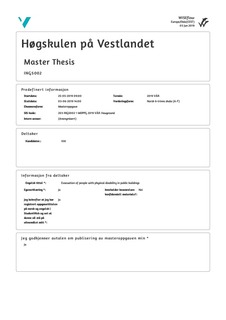| dc.description.abstract | Today, more focus is put on evacuation safety of disabled people. In this thesis, evacuation and safety of disabled persons will be investigated in buildings open for the public, such as shopping malls, conference centre and office buildings. There were performed evacuation exercises in two buildings and observation of a drill in a third building. In each building were performed three exercises, and a questionnaire was answered by the participants afterwards. In addition, an evacuation drill, that was performed in an office building, was observed to see the evacuation of a disabled person that was located in the building.
In the evacuation exercises the main obstacles discovered were staircases that the participants were unable to use to evacuate out of the buildings. The evacuation exercises also showed a lack of signage in some evacuation routes and that the refuge areas were not marked with clear and visible signs. The communication device in the refuge area should also be marked with clear and understandable signs for easy use. The participants were not familiar with the concept of refuge area.
There were also performed evacuation simulations in Pathfinder for each evacuation exercise performed. In the simulations two movement speeds were tested: 1.19 m/s and movement speed profile from SINTEF rapport. The movement speed profiles were 0.10-1.68 m/s for non-disabled occupants and 0.13-1.35 m/s for disabled occupants.
The results from the simulations showed that the disabled occupant travels a slightly longer distance than the non-disabled occupant. In addition, the non-disable occupant has on average faster movement speed than the disabled occupant. This results in shorter evacuation time for the non-disabled occupant compared to the disabled. The average evacuation time, calculated from the results from the simulations of the movement speed profile from SINTEF, have large values of standard deviation. The non-disabled occupant has on average larger standard deviation for the average evacuation time than the disabled occupant.
When the results from the evacuation exercises were compared to the results from the simulations, it showed that the movement speed of 1.19 m/s give more realistic results for the evacuation time of a disabled person rather than the use of average values from ranged movement speed profile. | nb_NO |

